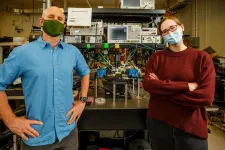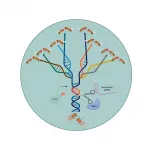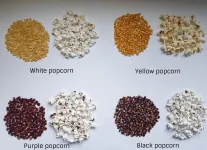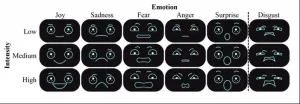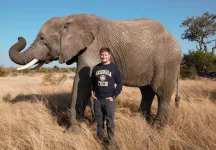(Press-News.org) ALBUQUERQUE, N.M. -- Scientists at Sandia National Laboratories have built the world's smallest and best acoustic amplifier. And they did it using a concept that was all but abandoned for almost 50 years.
According to a paper published May 13 in Nature Communications, the device is more than 10 times more effective than the earlier versions. The design and future research directions hold promise for smaller wireless technology.
Modern cell phones are packed with radios to send and receive phone calls, text messages and high-speed data. The more radios in a device, the more it can do. While most radio components, including amplifiers, are electronic, they can potentially be made smaller and better as acoustic devices. This means they would use sound waves instead of electrons to process radio signals.
"Acoustic wave devices are inherently compact because the wavelengths of sound at these frequencies are so small -- smaller than the diameter of human hair," Sandia scientist Lisa Hackett said. But until now, using sound waves has been impossible for many of these components.
Sandia's acoustic, 276-megahertz amplifier, measuring a mere 0.0008 square inch (0.5 square millimeter), demonstrates the vast, largely untapped potential for making radios smaller through acoustics. To amplify 2 gigahertz frequencies, which carry much of modern cell phone traffic, the device would be even smaller, 0.00003 square inch (0.02 square millimeter), a footprint that would comfortably fit inside a grain of table salt and is more than 10 times smaller than current state-of-the-art technologies.
The team also created the first acoustic circulator, another crucial radio component that separates transmitted and received signals. Together, the petite parts represent an essentially uncharted path toward making all technologies that send and receive information with radio waves smaller and more sophisticated, said Sandia scientist Matt Eichenfield.
"We are the first to show that it's practical to make the functions that are normally being done in the electronic domain in the acoustic domain," Eichenfield said.
Resurrecting a decades-old design
Scientists tried making acoustic radio-frequency amplifiers decades ago, but the last major academic papers from these efforts were published in the 1970s.
Without modern nanofabrication technologies, their devices performed too poorly to be useful. Boosting a signal by a factor of 100 with the old devices required 0.4 inch (1 centimeter) of space and 2,000 volts of electricity. They also generated lots of heat, requiring more than 500 milliwatts of power.
The new and improved amplifier is more than 10 times as effective as the versions built in the '70s in a few ways. It can boost signal strength by a factor of 100 in 0.008 inch (0.2 millimeter) with only 36 volts of electricity and 20 milliwatts of power.
Previous researchers hit a dead end trying to enhance acoustic devices, which are not capable of amplification or circulation on their own, by using layers of semiconductor materials. For their concept to work well, the added material must be very thin and very high quality, but scientists only had techniques to make one or the other.
Decades later, Sandia developed techniques to do both in order to improve photovoltaic cells by adding a series of thin layers of semiconducting materials. The Sandia scientist leading that effort happened to share an office with Eichenfield.
"I had some pretty heavy peripheral exposure. I heard about it all the time in my office," Eichenfield said. "So fast forward probably three years later, I was reading these papers out of curiosity about this acousto-electric amplifier work and reading about what they tried to do, and I realized that this work that Sandia had done to develop these techniques for essentially taking very, very thin semiconductors and transferring them onto other materials was exactly what we would need to make these devices realize all their promise."
Sandia made its amplifier with semiconductor materials that are 83 layers of atoms thick -- 1,000 times thinner than a human hair.
Fusing an ultrathin semiconducting layer onto a dissimilar acoustic device took an intricate process of growing crystals on top of other crystals, bonding them to yet other crystals and then chemically removing 99.99% of the materials to produce a perfectly smooth contact surface. Nanofabrication methods like this are collectively called heterogeneous integration and are a research area of growing interest at Sandia's Microsystems Engineering, Science and Applications complex and throughout the semiconductor industry.
Amplifiers, circulators and filters are normally produced separately because they are dissimilar technologies, but Sandia produced them all on the same acousto-electric chip. The more technologies that can be made on the same chip, the simpler and more efficient manufacturing becomes. The team's research shows that the remaining radio signal processing components could conceivably be made as extensions of the devices already demonstrated.
Work was funded by Sandia's Laboratory Directed Research and Development program and the Center for Integrated Nanotechnologies, a user facility jointly operated by Sandia and Los Alamos national laboratories.
So how long until these petite radio parts are inside your phone? Probably not for a while, Eichenfield said. Converting mass-produced, commercial products like cell phones to all acousto-electric technology would require a massive overhaul of the manufacturing infrastructure, he said. But for small productions of specialized devices, the technology holds more immediate promise.
The Sandia team is now exploring whether they can adapt their technology to improve all-optical signal processing, too. They are also interested in finding out if the technology can help isolate and manipulate single quanta of sound, called phonons, which would potentially make it useful for controlling and making measurements in some quantum computers.
INFORMATION:
Sandia National Laboratories is a multimission laboratory operated by National Technology and Engineering Solutions of Sandia LLC, a wholly owned subsidiary of Honeywell International Inc., for the U.S. Department of Energy's National Nuclear Security Administration. Sandia Labs has major research and development responsibilities in nuclear deterrence, global security, defense, energy technologies and economic competitiveness, with main facilities in Albuquerque, New Mexico, and Livermore, California.
Twice a day, at dusk and just before dawn, a faint layer of sodium and other metals begins sinking down through the atmosphere, about 90 miles high above the city of Boulder, Colorado. The movement was captured by one of the world's most sensitive "lidar" instruments and reported today in the AGU journal Geophysical Research Letters.
The metals in those layers come originally from rocky material blasting into Earth's atmosphere from space, and the regularly appearing layers promise to help researchers understand better how earth's atmosphere interacts with space, even potentially how those interactions help support life.
"This is an important discovery because we have never seen these dusk/dawn features before, and because these metal layers affect many things. The ...
DALLAS, June 2, 2021 -- A "prescription" to sit less and move more is the optimal first treatment choice for reducing mild to moderately elevated blood pressure and blood cholesterol in otherwise healthy adults, according to the new American Heart Association scientific statement published today in the American Heart Association's journal Hypertension.
"The current American Heart Association guidelines for diagnosing high blood pressure and cholesterol recognize that otherwise healthy individuals with mildly or moderately elevated levels of these ...
A large group of iconic fossils widely believed to shed light on the origins of many of Earth's animals and the communities they lived in may be hiding a secret.
Scientists, led by two from the University of Portsmouth, UK, are the first to model how exceptionally well preserved fossils that record the largest and most intense burst of evolution ever seen could have been moved by mudflows.
The finding, published in Communications Earth & Environment, offers a cautionary note on how palaeontologists build a picture from the remains of the creatures they study.
Until now, it has been widely accepted the fossils buried in mudflows in the Burgess Shale in Canada that show the result of the Cambrian ...
CRISPR-based technologies offer enormous potential to benefit human health and safety, from disease eradication to fortified food supplies. As one example, CRISPR-based gene drives, which are engineered to spread specific traits through targeted populations, are being developed to stop the transmission of devastating diseases such as malaria and dengue fever.
But many scientists and ethicists have raised concerns over the unchecked spread of gene drives. Once deployed in the wild, how can scientists prevent gene drives from uncontrollably spreading across populations ...
CHICAGO -- Women who experience acute aortic dissection--a spontaneous and catastrophic tear in one of the body's main arteries--not only are older and have more advanced disease than men when they seek medical care, but they also are more likely to die, according to research published online today in The Annals of Thoracic Surgery.
"Data over the course of the last few decades demonstrate differences in both presentation and outcomes between males and females who have acute aortic dissection, with greater mortality among females," said Thomas G. Gleason, MD, from Brigham and Women's Hospital in Boston, Massachusetts. "This study underscores ...
Can you trust the map on your smartphone, or the satellite image on your computer screen?
So far, yes, but it may only be a matter of time until the growing problem of "deep fakes" converges with geographical information science (GIS). Researchers such as Associate Professor of Geography Chengbin Deng are doing what they can to get ahead of the problem.
Deng and four colleagues -- Bo Zhao and Yifan Sun at the University of Washington, and Shaozeng Zhang and Chunxue Xu at Oregon State University -- co-authored a recent article in Cartography and Geographic Information Science that explores the problem. In "Deep ...
Popcorn. What would movies and sporting events without this salty, buttery snack? America's love for this snack goes beyond these events. We consume 15 billion quarts of popped popcorn each year.
When it comes to popcorn, consumers want a seed-to-snack treat that leaves more snacks than seeds when popped. This means when they pop the corn, there shouldn't be many unpopped kernels left in the bowl.
Maria Fernanda Maioli set out to determine the properties affecting popping expansion in popcorn. The team's research was recently published in Agronomy Journal, a publication of the American Society of Agronomy.
"The way kernels expand is a basic, ...
BEER-SHEVA, Israel...June 2, 2021 - As drones become more ubiquitous in public spaces, researchers at Ben-Gurion University of the Negev (BGU) have conducted the first studies examining how people respond to various emotional facial expressions depicted on a drone, with the goal of fostering greater social acceptance of these flying robots.
The research, which was presented recently at the virtual ACM Conference on Human Factors in Computing Systems, reveals how people react to common facial expressions superimposed on drones.
"There is a lack of research on how drones are perceived and understood by humans, which is vastly different than ground robots." says Prof. Jessica Cauchard together with Viviane Herdel of BGU's Magic Lab, in the BGU Department of Industrial ...
New research from the Georgia Institute of Technology finds that elephants dilate their nostrils in order to create more space in their trunks, allowing them to store up to nine liters of water. They can also suck up three liters per second -- a speed 50 times faster than a human sneeze (150 meters per second/330 mph).
The Georgia Tech College of Engineering study sought to better understand the physics of how elephants use their trunks to move and manipulate air, water, food and other objects. They also sought to learn if the mechanics could inspire the creation of more efficient robots that use air motion to hold and move things.
While octopus use jets of water to move and archer fish shoot water above the surface to catch insects, the Georgia Tech researchers found that elephants ...
Boulder, Colo., USA: Article topics include Zealandia, Earth's newly recognized continent; the topography of Scandinavia; an interfacial energy penalty; major disruptions in North Atlantic circulation; the Great Bahama Bank; Pityusa Patera, Mars; the end-Permian extinction; and Tongariro and Ruapehu volcanoes, New Zealand. These Geology articles are online at https://geology.geoscienceworld.org/content/early/recent.
Mass balance controls on sediment scour and bedrock erosion in waterfall plunge pools
Joel S. Scheingross; Michael P. Lamb
Abstract: Waterfall plunge pools experience cycles of sediment aggradation and scour that modulate ...
